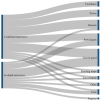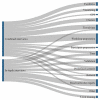Travel scenario workshops for geographical accessibility modeling of health services: A transdisciplinary evaluation study
- PMID: 36743157
- PMCID: PMC9889992
- DOI: 10.3389/fpubh.2022.1051522
Travel scenario workshops for geographical accessibility modeling of health services: A transdisciplinary evaluation study
Abstract
Introduction: Limited geographical access to quality Emergency Obstetric and Newborn Care (EmONC) is a major driver of high maternal mortality. Geographic access to EmONC facilities is identified by the global community as a critical issue for reducing maternal mortality and is proposed as a global indicator by the Ending Preventable Maternal Mortality (EPMM) initiative. Geographic accessibility models can provide insight into the population that lacks adequate access and on the optimal distribution of facilities and resources. Travel scenarios (i.e., modes and speed of transport) used to compute geographical access to healthcare are a key input to these models and should approximate reality as much as possible. This study explores strategies to optimize and harmonize knowledge elicitation practices for developing travel scenarios.
Methods: Knowledge elicitation practices for travel scenario workshops (TSW) were studied in 14 African and South-Asian countries where the United Nations Population Fund supported ministries of health and governments in strengthening networks of EmONC facilities. This was done through a mixed methods evaluation study following a transdisciplinary approach, applying the four phases of the Interactive Learning and Action methodology: exploration, in-depth, integration, and prioritization and action planning. Data was collected in November 2020-June 2021 and involved scoping activities, stakeholder identification, semi-structured interviews (N = 9), an evaluation survey (N = 31), and two co-creating focus group discussions (N = 8).
Results: Estimating realistic travel speeds and limited time for the workshop were considered as the largest barriers. The identified opportunities were inclusively prioritized, whereby preparation; a favorable composition of attendees; validation practices; and evaluation were anticipated to be the most promising improvement strategies, explaining their central place on the co-developed initial standard operating procedure (SOP) for future TSWs. Mostly extensive preparation-both on the side of the organization and the attendees-was anticipated to address nearly all of the identified TSW challenges.
Conclusion: This study showed that the different identified stakeholders had contradicting, complementing and overlapping ideas about strategies to optimize and harmonize TSWs. Yet, an initial SOP was inclusively developed, emphasizing practices for before, during and after each TSW. This SOP is not only relevant in the context of the UNFPA EmONC development approach, but also for monitoring the newly launched EPMM indicator and even in the broader field of geographic accessibility modeling.
Keywords: emergency obstetric care; geographic accessibility; interactive learning; maternal health; travel scenario.
Copyright © 2023 Molenaar, Hierink, Brun, Monet and Ray.
Conflict of interest statement
The authors declare that the research was conducted in the absence of any commercial or financial relationships that could be construed as a potential conflict of interest.
Figures







References
-
- United Nations . The Sustainable Development Goals Report. (2020). Available online at: https://unstats.un.org/sdgs/report/2020/The-Sustainable-Development-Goal... (accessed August 2, 2022).
-
- World Health Organization . Maternal Mortality. Available online at: https://www.who.int/news-room/fact-sheets/detail/maternal-mortality (accessed August 2, 2022).
MeSH terms
LinkOut - more resources
Full Text Sources
Medical

